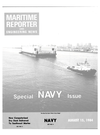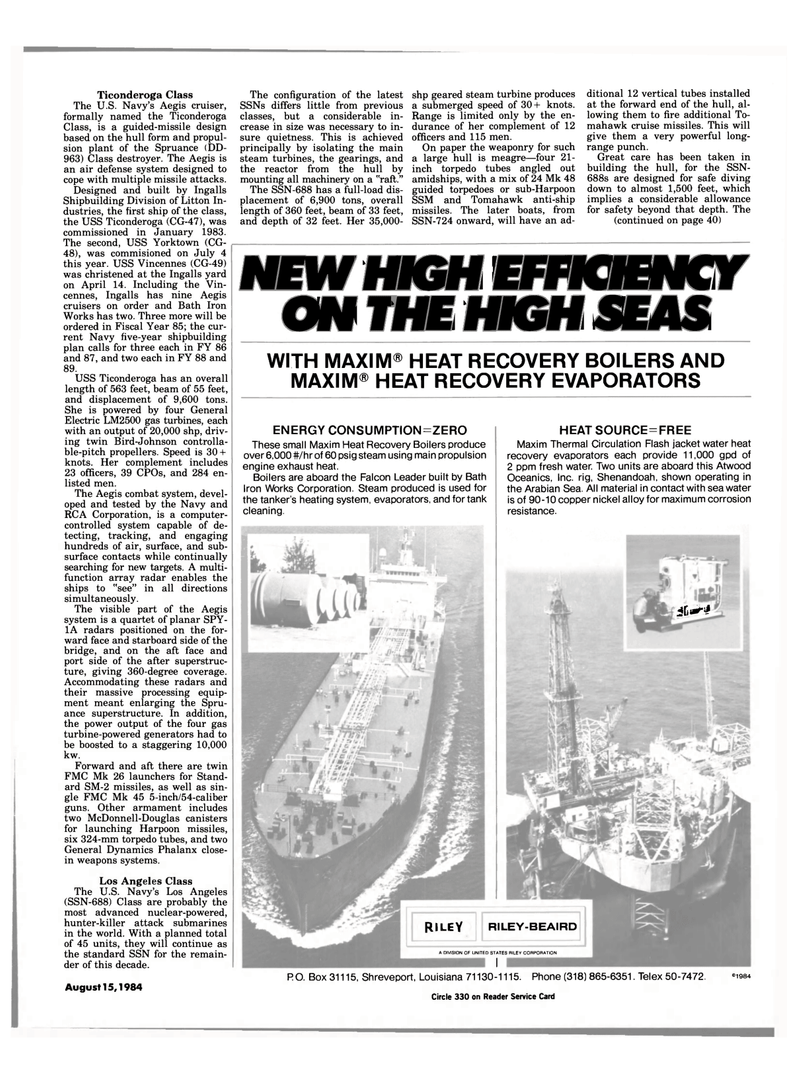
Page 37: of Maritime Reporter Magazine (August 15, 1984)
Read this page in Pdf, Flash or Html5 edition of August 15, 1984 Maritime Reporter Magazine
Ticonderoga Class
The U.S. Navy's Aegis cruiser, formally named the Ticonderoga
Class, is a guided-missile design based on the hull form and propul- sion plant of the Spruance (DD- 963) Class destroyer. The Aegis is an air defense system designed to cope with multiple missile attacks.
Designed and built by Ingalls
Shipbuilding Division of Litton In- dustries, the first ship of the class, the USS Ticonderoga (CG-47), was commissioned in January 1983.
The second, USS Yorktown (CG- 48), was commisioned on July 4 this year. USS Vincennes (CG-49) was christened at the Ingalls yard on April 14. Including the Vin- cennes, Ingalls has nine Aegis cruisers on order and Bath Iron
Works has two. Three more will be ordered in Fiscal Year 85; the cur- rent Navy five-year shipbuilding plan calls for three each in FY 86 and 87, and two each in FY 88 and 89.
USS Ticonderoga has an overall length of 563 feet, beam of 55 feet, and displacement of 9,600 tons.
She is powered by four General
Electric LM2500 gas turbines, each with an output of 20,000 shp, driv- ing twin Bird-Johnson controlla- ble-pitch propellers. Speed is 30 + knots. Her complement includes 23 officers, 39 CPOs, and 284 en- listed men.
The Aegis combat system, devel- oped and tested by the Navy and
RCA Corporation, is a computer- controlled system capable of de- tecting, tracking, and engaging hundreds of air, surface, and sub- surface contacts while continually searching for new targets. A multi- function array radar enables the ships to "see" in all directions simultaneously.
The visible part of the Aegis system is a quartet of planar SPY- 1A radars positioned on the for- ward face and starboard side of the bridge, and on the aft face and port side of the after superstruc- ture, giving 360-degree coverage.
Accommodating these radars and their massive processing equip- ment meant enlarging the Spru- ance superstructure. In addition, the power output of the four gas turbine-powered generators had to be boosted to a staggering 10,000 kw.
Forward and aft there are twin
FMC Mk 26 launchers for Stand- ard SM-2 missiles, as well as sin- gle FMC Mk 45 5-inch/54-caliber guns. Other armament includes two McDonnell-Douglas canisters for launching Harpoon missiles, six 324-mm torpedo tubes, and two
General Dynamics Phalanx close- in weapons systems.
Los Angeles Class
The U.S. Navy's Los Angeles (SSN-688) Class are probably the most advanced nuclear-powered, hunter-killer attack submarines in the world. With a planned total of 45 units, they will continue as the standard SSN for the remain- der of this decade.
August 15,1984
The configuration of the latest
SSNs differs little from previous classes, but a considerable in- crease in size was necessary to in- sure quietness. This is achieved principally by isolating the main steam turbines, the gearings, and the reactor from the hull by mounting all machinery on a "raft."
The SSN-688 has a full-load dis- placement of 6,900 tons, overall length of 360 feet, beam of 33 feet, and depth of 32 feet. Her 35,000- shp geared steam turbine produces a submerged speed of 30 + knots.
Range is limited only by the en- durance of her complement of 12 officers and 115 men.
On paper the weaponry for such a large hull is meagre—four 21- inch torpedo tubes angled out amidships, with a mix of 24 Mk 48 guided torpedoes or sub-Harpoon
SSM and Tomahawk anti-ship missiles. The later boats, from
SSN-724 onward, will have an ad- ditional 12 vertical tubes installed at the forward end of the hull, al- lowing them to fire additional To- mahawk cruise missiles. This will give them a very powerful long- range punch.
Great care has been taken in building the hull, for the SSN- 688s are designed for safe diving down to almost 1,500 feet, which implies a considerable allowance for safety beyond that depth. The (continued on page 40)
NEW HIGH EFFICIENCY ON THE HIGH SEAS
WITH MAXIM® HEAT RECOVERY BOILERS AND
MAXIM® HEAT RECOVERY EVAPORATORS ifi-iM
RILEY RILEY-BEAIRD
A DIVISION OF UNITED STATES RILEY CORPORATION
I
RO. Box 31115, Shreveport, Louisiana 71130-1115. Phone (318) 865-6351. Telex 50-7472. <=1984
Circle 330 on Reader Service Card
ENERGY CONSUMPTION=ZERO
These small Maxim Heat Recovery Boilers produce over 6,000 #/hr of 60 psig steam using main propulsion engine exhaust heat.
Boilers are aboard the Falcon Leader built by Bath
Iron Works Corporation. Steam produced is used for the tanker's heating system, evaporators, and for tank cleaning.
HEAT SOURCE=FREE
Maxim Thermal Circulation Flash jacket water heat recovery evaporators each provide 11,000 gpd of 2 ppm fresh water. Two units are aboard this Atwood
Oceanics, Inc. rig, Shenandoah, shown operating in the Arabian Sea. All material in contact with sea water is of 90-10 copper nickel alloy for maximum corrosion resistance.

 36
36

 38
38
